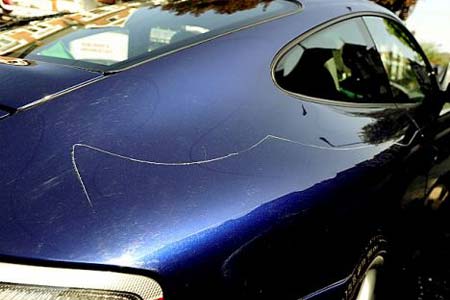
Have you ever gone to your car here in Harford County and found that some evil culprit keyed your hood? Or have you ever washed your car and discovered later that the cloth you used was too abrasive and left minor scratches everywhere? Then there are the assorted scratches from tree branches, road construction, and gravel that can leave tons of irritating scratches on your vehicle.
If you have ever experienced any of these, you’re not alone. So what do you do?
Well, first you need to determine the extent of the damage. It might not even be a scratch at all—it could be residue from another surface that made contact with your car, like a shopping cart or a rubber ball. A good idea is to gently wash the surface with a soap and water, being sure not to use any abrasive materials. If the mark doesn’t disappear, then it is likely to be a real scratch.
Next you’ll need to gauge how deep the scratch is. A car’s paint typically consists of primer, paint, and a top clear coat. If the scratch is in the clear coat, it is much easier to remove, as you can imagine. In the handy guide from Popular Mechanics, they suggest using the following DIY strategy for sanding away minor scratches in the clear coat:
-
The key to sanding safely is to use an ultrafine 2000- to 3000-grit wet/dry sandpaper, which is available at auto parts stores where body shop supplies are sold. Place the paper on a rubber sanding block or a wood block, then dip it in a bowl of cold water. Add two or three drops of liquid dish detergent to make the water more slippery and to improve cutting action. Sand the scratch area using light, short strokes at alternating 60-degree angles to the scratch. Move up and down the length of the scratch, stopping frequently to rinse the paper in the water. The goal is to work slowly and lightly until you see the contrasting mark disappear.
-
Once it is gone, dry the sanded area thoroughly and inspect it for any signs of the scratch. If you have clearcoat paint and the sanding water shows any sign of color, you’ll have to respray the clear. If you have conventional (nonclearcoat) enamel or lacquer, the water will show plenty of color. Once the scratch is gone — and you haven’t sanded down to the next layer — buff the area with rubbing compound. A power buffer works fast, but you can do a fine job on smaller areas with no more than a terry cloth washcloth and a bottle of compound. Buff in a circular motion, and lift up the haze with a terry cloth towel.
-
When the sandpaper scratches are gone, use a soft cloth to remove any of the relatively coarse compound. You may need to wash the area with water. Replace the rubbing-compound pad on the machine with a foam polishing-compound pad, and buff the entire area with very fine compound or swirl mark eliminator. Once the polishing is done, inspect the area, then seal the paint with car wax.
Be sure to follow the link above to see Popular Mechanics’ great photo demonstration of these methods.
If you want to save yourself the trouble or if the scratch goes deeper than the clear coat, then give Bel Air Autobody a call. We can match your vehicle’s color exactly. You might be surprised at how many shades of colors are available for cars nowadays. With such a variety, color-matching requires a lot of precision. Also, most vehicles experience color changes over time due to exposure to the elements, which could make the process even trickier! On top of that, our process is computerized, eliminating the potential for error. We guarantee that we will achieve an accurate match to the color of your vehicle.
